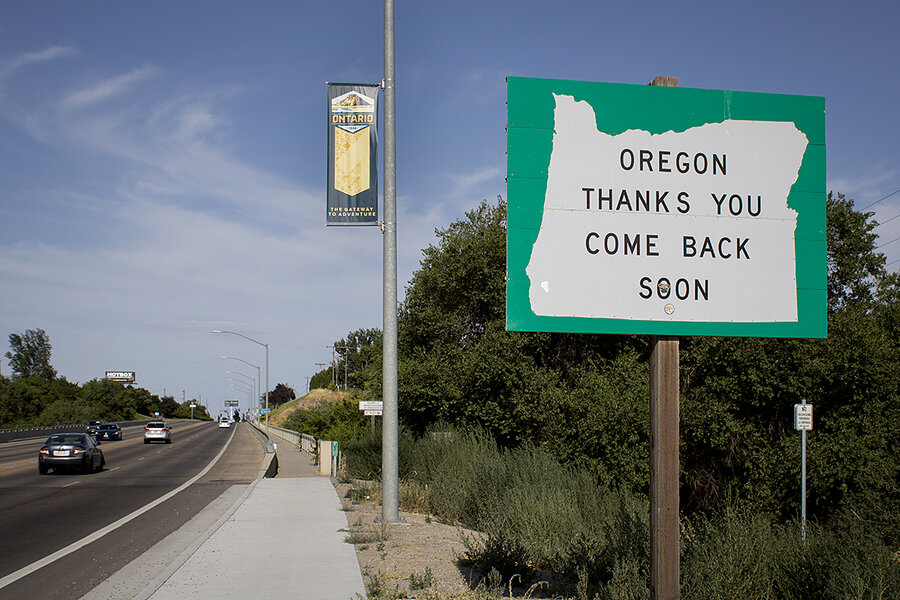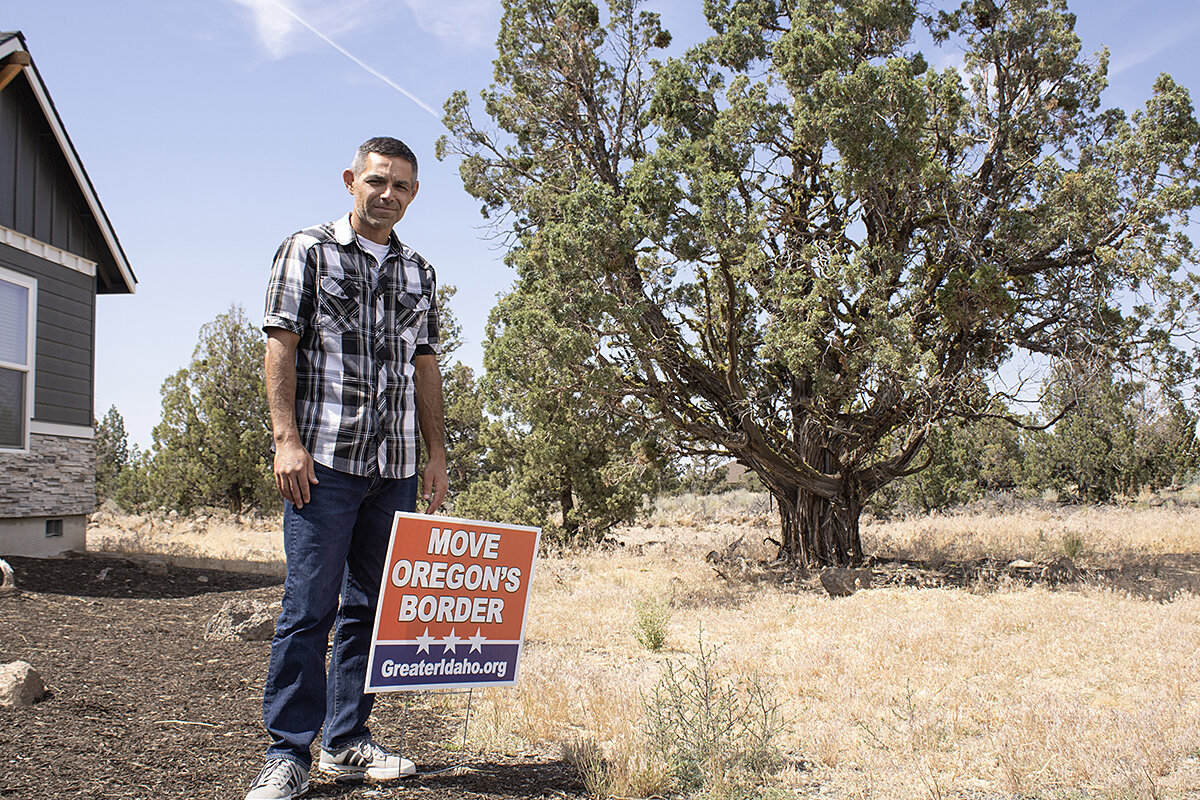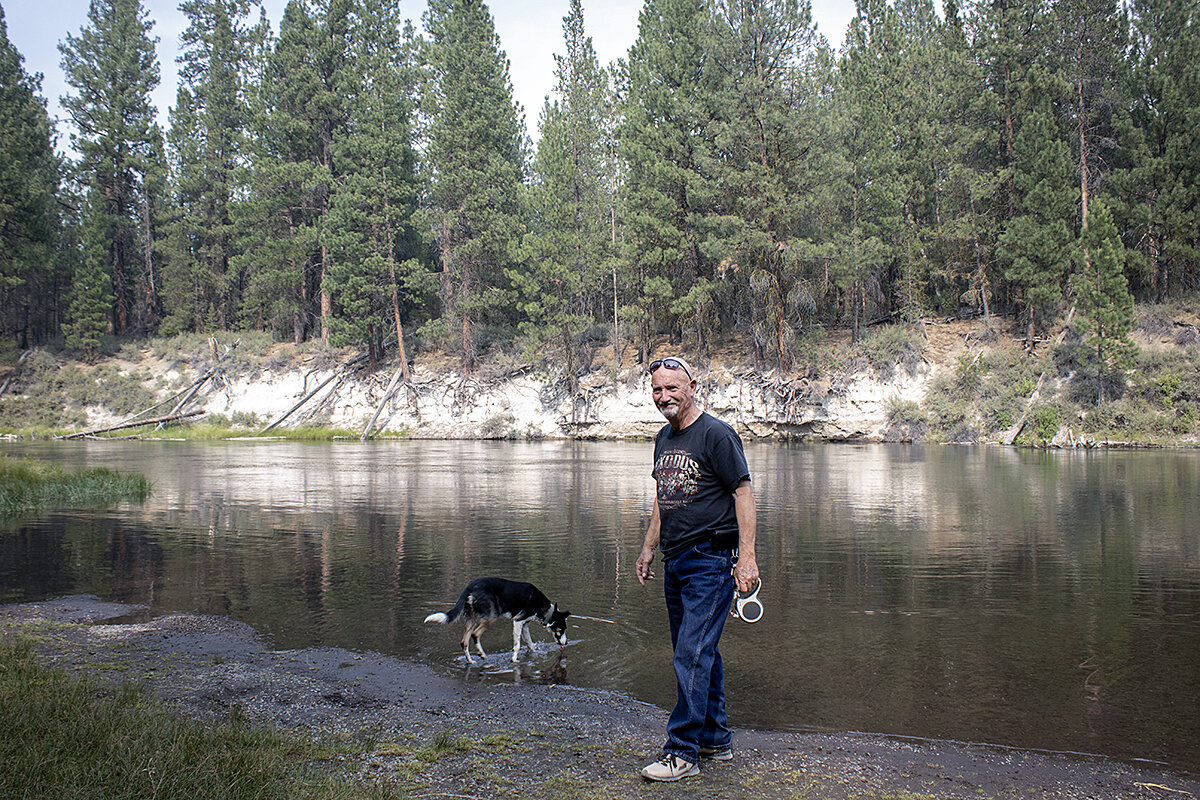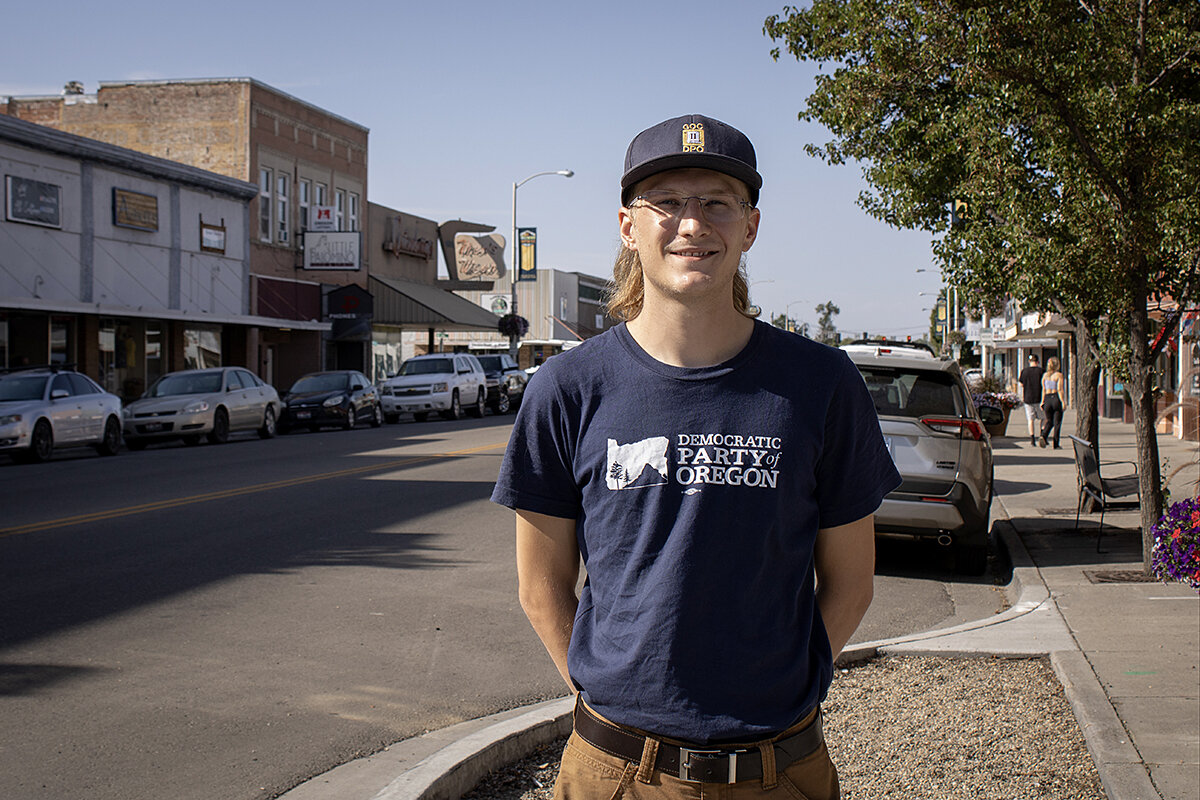Break free from Portland? Why eastern Oregon wants to join Idaho.
Loading...
| The Oregon-Idaho border
Hidden somewhere beneath the Snake River’s flowing brown water lies the exact dividing line separating one of America’s most liberal states from one of its most conservative.
But according to a group of rural, conservative secessionists, the Oregon-Idaho border should be moved 300 miles west.
It may be a pipe dream, but the Greater Idaho movement has been picking up steam over the past few years to become the most active secessionist movement in modern America. These eastern Oregonians say their home state’s politics, dominated by infamously progressive Portland in the west, don’t reflect their values. So they’re trying to get their rural, conservative neighbor, Idaho, to absorb them.
Why We Wrote This
The Greater Idaho movement’s recent momentum toward the goal of redrawing Oregon’s boundary highlights the depth of the urban-rural divide in America.
“If you stuck someone who’s lived in the city all their lives over here in the rural areas, they wouldn’t know how to survive,” says Toni Foster, who owns a wrecking yard and upholstery business in Harney County, the state’s most sparsely populated county, with fewer than 8,000 people. The state government in Salem is always telling the rest of Oregon “how they want you to live your life,” says Ms. Foster, taking a break from canning vegetables in her kitchen. “And that just makes rural areas angrier and more upset. We’re not being listened to.”
With cities increasingly voting Democratic and less-populated areas increasingly voting Republican, this urban-rural divide has become a defining factor in U.S. politics. And as the political parties grow further apart ideologically, that gaping red-blue split isn’t just between states – but also often within them.
Almost nowhere in America is this dynamic starker than in Oregon, where the land west of the Cascade Range is characterized by rainy, dense fir forests and Democrats, while east of the mountains are dry high deserts and Republicans. And while it’s unlikely that Oregon’s border will ever actually move from the Snake River – such a shift would require approval from both states’ legislatures and the U.S. Congress – the Greater Idaho movement’s incremental successes of late show how deep the country’s urban-rural divide has become, and the lengths to which some voters may be willing to go to claw back a sense of power.
“We were forced into this grouping a long time ago, and it doesn’t make sense. Our communities are too different. It creates this feeling of, ‘You don’t understand us, you don’t respect us, and you don’t listen to us,’” says Matt McCaw, spokesperson for the Greater Idaho movement. “Unless we help people get the government they want, we’re going to have this bitterness.”
A values gap
Mr. McCaw moved from a Portland suburb to Powell Butte in 2020 with his wife and seven children. They had always felt a little different than their neighbors – more conservative, more religious. But when the state government took what they viewed as a “heavy-handed” approach to the COVID-19 pandemic, the McCaws, who own a wedding venue and math curriculum consulting business, decided they needed to move east, where people were similarly frustrated by the restrictions.
Yet even after they settled in Crook County, which former President Donald Trump won by almost 50 points in 2020, they found themselves still feeling frustrated.
“Eastern Oregon was forced into all of these pandemic policies that we didn’t want – and right next door in Idaho it was totally different,” he says. In Idaho, families were going to church and kids were going to school. So when Mr. McCaw heard about the Greater Idaho movement, “it clicked.”
“If the government is going to have that much control over your life, you really need to make sure that that government matches your values,” he says from his home in Powell Butte, where the smell of juniper trees and sagebrush fills the air. “COVID brought the blue-red state divide into stark contrast.”
Other recent measures have heightened that sense of a values gap. Ballot Measure 110, which decriminalized possession of drugs like heroin, fentanyl, and meth, passed statewide in November 2020 despite opposition in the double digits from every eastern Oregon county. In 2022, Measure 114, which requires permits from local law enforcement to buy firearms and prohibits ammunition magazines capable of holding more than 10 rounds, passed with only six counties – three in and around Portland and three in and around Salem – voting in favor.
“We have just watched western Oregon get more and more progressive,” says Sandie Gilson, a small-business owner and fifth-generation eastern Oregonian.
At first, she says, she was inclined to shrug it off. “It was like, ‘Well, just let them do what they want to do.’” But increasingly, Ms. Gilson says, it feels like the state’s progressive policies are becoming a threat to their lives. Where she lives in Grant County, which is slightly smaller than the state of Connecticut, the police are often hours away. If she were to face a situation like a home intrusion or an approaching cougar or wolf, “I’m supposed to run back in my house, unlock my safe, find my bullets, load it, before I can save somebody? We just live a totally different lifestyle,” she says.
In November 2020, eastern Oregon’s Jefferson and Union counties approved ballot measures requiring county commissioners to hold meetings about relocating the Oregon-Idaho border. Over the next three years, 10 more counties approved similar measures, including most recently Wallowa County, which voted in May to require biannual meetings on the subject.
The ballot measure failed in two southwest Oregon counties, leading the Greater Idaho movement to redraw its original proposed map that would have included them. Now, its “Phase 1” map focuses only on Oregon east of the Cascade Range (while carefully carving out Bend, a fast-growing liberal city in central Oregon). And a possible “Phase 2” would include rural parts of Northern California and southeast Washington.
Is a boundary redraw possible?
Advocates like Ms. Gilson say they are confident they can get there. When she went door to door in Grant County gathering signatures to make it onto the ballot, she says 3 out of every 4 people signed her petition before she even finished her pitch.
But passing a ballot measure that simply asks local officials to discuss the idea is a far cry from persuading two state legislatures as well as the U.S. Congress.
“There are so many barriers to getting it done that there would have to be a strong feeling across the board that we need new boundaries,” says Francis Buckley, a professor at George Mason University School of Law and author of the 2020 book “American Secession: The Looming Threat of a National Breakup.”
State boundaries have been moved before. Virginia and West Virginia split over disagreements during the Civil War. In 1958, Congress passed a law approving a slight boundary change between Oregon and Washington to track with a shifting river. A few years later, a similar law was passed for the boundary between Minnesota and North Dakota.
But Mr. Buckley thinks a statewide secession from the United States is actually more likely at this point in American history than a boundary redraw – he posits that California, for example, might consider seceding if Mr. Trump wins in 2024. Still, he says movements like Greater Idaho aren’t necessarily a bad thing, “if the goal is to sort ourselves out better.”
For that to happen, Republican lawmakers from eastern Oregon would have to agree to lose a chunk of their own constituents (and hence their own power) while Democrats in western Oregon would have to be convinced there are “political gains to be made” by lopping off such a big swath of land and voters. Both seem highly unlikely, says Mr. Buckley, given that Democrats’ statewide control isn’t currently threatened by the hundreds of thousands of Republican voters to the east. Oregon has had a Democratic governor for over three decades and Democratic supermajorities in at least one chamber of the state legislature for 10 of the past 20 years. Portland has more residents than all of eastern Oregon combined.
But Greater Idaho advocates are convinced that their proposal is a win-win. Idaho would gain around 400,000 new residents who vote similarly to the rest of the state (these Oregon counties voted for Mr. Trump in 2020 at similar rates to Idaho’s statewide average), and Oregon could “cut their losses,” as Greater Idaho’s website puts it, by getting rid of the half of the state they currently subsidize with tax dollars.
What’s more, Greater Idaho President Mike McCarter and his colleagues say that while they are pursuing this divorce from Portland and Salem civilly and peacefully, their efforts act as a kind of pressure valve for stronger frustrations roiling beneath the surface.
And it’s not just in their own state. Mr. McCarter says he’s been contacted by rural voters in both North Carolina and Illinois who want to pursue something similar. He’s been in touch with secessionists in Atlanta who want to break away from the city.
“People ask me, ‘Well, if you want to be a part of Idaho, why don’t you just pick up and move to Idaho?’” says Mr. McCarter, as his dog, Sable, splashes in the banks of the Deschutes River. He and his fellow members say it’s not that simple. This is where they own property and have families, and they shouldn’t have to move just because western Oregon is silencing their voice.
“Our movement is trying to offer a solution,” says Mr. McCaw. “It will lower political tension, and I think we can create a road map out here in Oregon for other places where it makes sense.”
“I happen to love Oregon”
Of course, not all eastern Oregonians are on board with the idea of merging with Idaho.
“I really do appreciate the concept, but I happen to love Oregon,” says Doris Davison, sitting outside the laundromat she owns in Hines with her two grandsons.
Some locals here point to potential downsides. Oregon’s minimum wage is nearly double that of Idaho’s – a change that could hit workers here hard. They’d also lose the benefits of Oregon’s lack of sales tax.
Then there’s the growing business of legalized marijuana. Ontario is an Oregon border city of fewer than 12,000 that airs Idaho news stations and shares a time zone with Boise. But last year, it produced more than $100 million in cannabis sales, second only to Portland’s Multnomah County. That growing source of revenue would be illegal in Idaho.
Giving rural economies like Ontario’s, where the poverty rate is almost double the national average, more of a share of cannabis tax revenue could help ease some of east Oregon’s frustrations, says Antonio Sunseri, vice chair of the Malheur County Democrats.
The Democratic Party also needs to do a better job of appealing to voters here, particularly young ones, and particularly around the issue of guns, he adds. Gun ownership is a part of rural life, says Mr. Sunseri, who is also a member of the Democratic Party of Oregon’s Gun Owners Caucus.
Mr. Sunseri, a fifth-generation resident of Malheur County with its rolling expanses of onion farms, is part of a group currently campaigning to get a repeal measure on the ballot in 2024 for a “revote” on the border relocation issue. But if it fails, he says he’ll likely drop the effort.
“If that vote fails and the majority of people in my county really want to join Idaho, I’m just going to have to change my mind about it because I’ve lived here my entire life,” says Mr. Sunseri. “It’s more important to me that this place is my home than one state or the other.”











